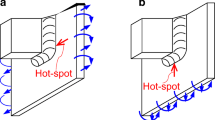Abstract
The effective notch stress approach to fatigue assessment of existing large-size specimens for diaphragm-to-rib welded connection in orthotropic steel deck is investigated. Two kinds of specimens are designed. Specimen 1 has the form of circular arc transition; specimen 2 has the form of vertical transition. The first principal stress distribution at weld toe and weld root is calculated by the sub-model method of ANSYS software. By means of the maximum first principal stress analysis, it is possible to distinguish whether fatigue cracks will initiate at the weld toe or the weld root, which is agreed with the fatigue test results. Furthermore, the fatigue strength of specimen 1 and specimen 2 are evaluated by the effective notch stress approach according to fatigue tests. Finally, the factors affecting the stress intensity at the weld toe are studied.
















Similar content being viewed by others
References
S.P. Michèle, C.B. Ronaldo, J.R.M. Aluísio, Stress concentration in steel bridge orthotropic decks. J. Constr. Steel Res. 61(8), 1172–1184 (2005)
D.B. Hans, O. Amelie, V.B. Philippe, Analytical calculation of internal forces in orthotropic plated bridge decks based on the slope-deflection method. J. Constr. Steel Res. 64(12), 1530–1539 (2008)
A. Mustafa, A. Mohammad, U. Shota, Modeling and fatigue life assessment of orthotropic bridge deck details using FEM. Int. J. Fatigue 40, 129–142 (2012)
M.H. Kolstein, Fatigue Classification of Welded Joints in Orthotropic Steel Bridge Decks (Delft University of Technology, Delft, 2007)
C. Miki, K. Tateishi, Fatigue strength of cope hole details in steel bridges. Int. J. Fatigue 19(6), 445–455 (1997)
Z.G. Xiao, K. Yamada, S. Ya, X.L. Zhao, Stress analyses and fatigue evaluation of rib-to-deck joints in steel orthotropic decks. Int. J. Fatigue 80(3), 1387–1397 (2008)
W. Roman, O. Alexis, Secondary stresses in closed orthotropic deck ribs at floor beams. J. Struct. Eng. 118(2), 582–595 (1992)
M.M. Pedersen, O.Ø. Mouritsen, M.R. Hansen et al., Re-analysis of fatigue data for welded joints using the notch stress approach. Int. J. Fatigue 32(10), 1620–1626 (2010)
G.B. Zhang, C.M. Sonsino, R. Sundermeier, Method of effective stress for fatigue: part II. Applications to V-notches and seam welds. Int. J. Fatigue 37, 24–40 (2012)
D. Radaj, Notch stress proof for fatigue resistant welded structures, IIW Document XIII-1157-85, West Germany (1985)
A. Hobbacher, Recommendations for fatigue design of welded joints and components, IIW Document XIII-2151-07/ XV-1254-07, Paris (2007)
Acknowledgments
This work is supported by the Fundamental Research Funds for the Central Universities (2013G1251032).
Author information
Authors and Affiliations
Corresponding author
Rights and permissions
About this article
Cite this article
Wang, B. Fatigue Assessment of the Diaphragm-to-Rib Welded Connection in Orthotropic Steel Deck Using Effective Notch Stress Approach. J Fail. Anal. and Preven. 15, 65–73 (2015). https://doi.org/10.1007/s11668-014-9909-0
Received:
Revised:
Published:
Issue Date:
DOI: https://doi.org/10.1007/s11668-014-9909-0




